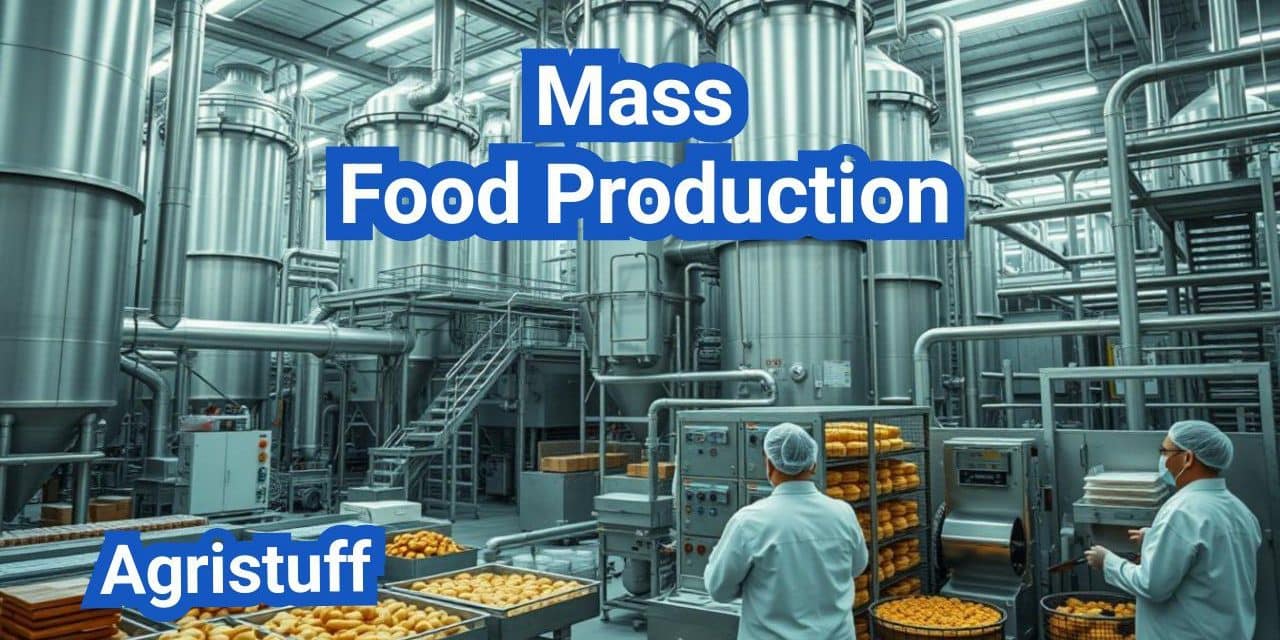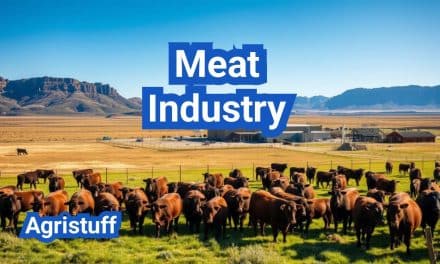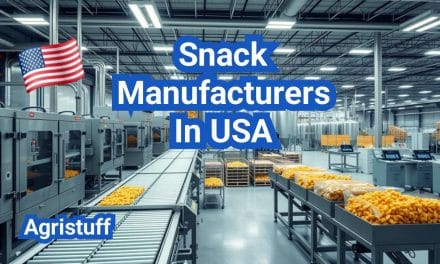The preparation of large quantities of food at once is a common practice in various commercial kitchen environments, including meal delivery businesses, ghost kitchens, and large-scale restaurants. This concept, known as mass food production, plays a significant role in meeting the demands of a growing population.
However, scaling food manufacturing processes safely and efficiently in U.S. plants poses significant challenges. Ensuring the quality and safety of the final product while maintaining high industrial food processing standards is crucial. As the demand for mass-produced food continues to rise, companies must adopt innovative solutions to overcome these challenges.
Key Takeaways
- Efficient scaling of food production is crucial for meeting growing demands.
- Mass food production companies face challenges in maintaining quality and safety.
- Industrial food processing standards must be upheld during scaling.
- Innovative solutions are necessary for overcoming scaling challenges.
- Safe and efficient food manufacturing practices are essential for U.S. plants.
Understanding Mass Food Production in the Modern Era
The evolution of industrial food processing has significantly impacted the global food landscape. As the world’s population continues to grow, the demand for safe, efficient, and sustainable food production methods has never been more pressing.
Definition and Evolution of Industrial Food Processing
Industrial food processing refers to the transformation of raw ingredients into consumable products on a large scale. This process has undergone significant changes over the years, driven by advances in technology, changes in consumer preferences, and the need for greater efficiency.
The industrialization of food production has led to the development of specialized manufacturing systems, capable of producing vast quantities of food. This transformation has not only increased food production but also impacted human and ecosystem health.
- Mechanization and automation of food processing
- Advances in packaging and preservation techniques
- Increased use of technology for monitoring and control
Key Components of the U.S. Food Manufacturing System
The U.S. food manufacturing system is a complex network of various components working together to produce and distribute food products. Key components include:
- Raw material sourcing and procurement
- Food processing and manufacturing
- Packaging and labeling
- Distribution and logistics
Understanding these components is crucial for appreciating the scale and complexity of mass food production in the modern era. The U.S. food manufacturing system plays a vital role in feeding the population, both domestically and internationally.
By examining the definition, evolution, and key components of industrial food processing, we can better understand the challenges and opportunities in this critical sector.
Analyzing the Current U.S. Mass Food Production Landscape

The current state of mass food production in the U.S. is marked by significant consolidation among manufacturers. This consolidation has led to a landscape where a few large companies dominate the market.
Leading Food Manufacturing Companies and Their Approaches
Companies such as Tyson Foods and Smithfield Foods are among the leading players in the U.S. mass food production industry. These companies have adopted various strategies to maintain their market share, including investing in automation and improving supply chain efficiency.
The meat and poultry industries are significant sectors within U.S. mass food production, with companies consuming large quantities of cereal and oilseed-based feeds. This has implications for both the economy and the environment.
Economic Impact and Market Dynamics
The economic impact of mass food production in the U.S. is substantial, contributing significantly to the GDP and providing employment to thousands of people. However, the industry is also subject to various market dynamics, including fluctuations in commodity prices and changing consumer preferences.
Market dynamics play a crucial role in shaping the industry, with factors such as demand for organic and non-GMO products influencing production practices. Companies that adapt quickly to these changes are more likely to maintain their competitive edge.
The U.S. food manufacturing system is complex, involving a range of stakeholders from farmers to processors. Understanding the intricacies of this system is essential for analyzing the current landscape of mass food production.
Selecting Essential Equipment for Efficient Mass Food Production
Mass food production facilities require a strategic selection of equipment to operate efficiently. The right machinery not only enhances productivity but also ensures consistency in the quality of the final product.
Critical Processing and Packaging Machinery
Investing in high-capacity, energy-efficient appliances is crucial for mass food production. Equipment such as tilt skillets and conveyor ovens are essential for large-scale food processing. These machines are designed for continuous operation, significantly increasing production capacity.
Automated packaging machines are another critical component. They not only speed up the packaging process but also improve accuracy and reduce labor costs. Examples include form-fill-seal machines and case packers.
“The right equipment can make all the difference in mass food production, enhancing both efficiency and product quality.”
Implementing Automation and Control Systems
Automation plays a vital role in modern mass food production. By implementing advanced control systems, manufacturers can achieve greater precision and consistency in their processes. This includes using programmable logic controllers (PLCs) and supervisory control and data acquisition (SCADA) systems.
- Improved process control
- Reduced human error
- Increased production flexibility
Developing Preventive Maintenance Programs
To ensure the longevity and efficiency of mass food production equipment, preventive maintenance is essential. Regular maintenance not only reduces the risk of equipment failure but also helps in maintaining product quality.
| Maintenance Activity | Frequency | Benefits |
|---|---|---|
| Equipment Cleaning | Daily | Prevents contamination, reduces wear |
| Lubrication of Moving Parts | Weekly | Reduces friction, prevents overheating |
| Inspection of Electrical Components | Monthly | Identifies potential issues before failure |
By focusing on these critical areas, mass food production facilities can significantly enhance their operational efficiency and product quality.
How to Develop and Implement Effective Food Safety Systems

To safeguard public health and maintain operational integrity, food producers must prioritize the development of comprehensive food safety systems. Effective food safety protocols are not just regulatory requirements; they are crucial for preventing contamination and ensuring the quality of food products.
Developing a robust food safety system involves several key components. First, it’s essential to understand the different elements that contribute to a comprehensive food safety plan.
Creating a Comprehensive HACCP Plan
A Hazard Analysis and Critical Control Points (HACCP) plan is a systematic approach to identifying and controlling hazards in the food production process. To create a comprehensive HACCP plan:
- Conduct a thorough hazard analysis to identify potential biological, chemical, and physical hazards.
- Determine Critical Control Points (CCPs) where controls can be applied to prevent or minimize hazards.
- Establish critical limits for each CCP, ensuring that the parameters are measurable and achievable.
- Implement monitoring procedures to ensure that CCPs are under control.
- Develop corrective actions to be taken when a CCP is not within the established critical limits.
- Establish verification procedures to ensure that the HACCP plan is working effectively.
- Maintain records of the HACCP plan and its implementation.
Example: A leading food manufacturer implemented a HACCP plan that included regular microbial testing at CCPs, resulting in a significant reduction in product recalls.
Establishing Preventive Controls for Human Food (PCHF)
Preventive Controls for Human Food (PCHF) are a critical component of the Food Safety Modernization Act (FSMA). PCHF requires food facilities to implement preventive controls to minimize or prevent hazards that could cause foodborne illness.
To establish PCHF, facilities must:
- Conduct a hazard analysis to identify potential hazards.
- Implement preventive controls, such as process controls, sanitation controls, and supply chain controls.
- Monitor and verify the effectiveness of these controls.
- Maintain records of the preventive controls and their implementation.
The importance of PCHF cannot be overstated, as it represents a proactive approach to food safety.
Maintaining Current Good Manufacturing Practices (cGMPs)
Current Good Manufacturing Practices (cGMPs) are regulations enforced by the FDA to ensure that food is manufactured, processed, packed, or held in a manner that prevents contamination. Maintaining cGMPs involves:
- Ensuring personnel hygiene and training.
- Maintaining clean and sanitary facilities and equipment.
- Implementing controls for raw materials and supplies.
- Conducting regular audits and inspections to ensure compliance.
By integrating HACCP plans, PCHF, and cGMPs, food manufacturers can develop a comprehensive food safety system that protects consumers and enhances operational efficiency.
Establishing a Robust Food Allergen Control Program
A robust food allergen control program is essential for preventing cross-contact and protecting consumers with food allergies. Food allergens pose a significant risk to consumer health, and their improper handling can lead to severe allergic reactions. Therefore, it is crucial for food manufacturers to implement effective measures to control and manage allergens throughout their production processes.
Designing Allergen Mapping and Segregation Protocols
The first step in establishing a food allergen control program is to design comprehensive allergen mapping and segregation protocols. This involves identifying all potential allergens present in the manufacturing facility, including raw materials, ingredients, and finished products. Allergen mapping requires a thorough analysis of the production process to determine where allergens are introduced, processed, and potentially transferred to other products or areas.
Once allergens are identified and mapped, the next step is to implement effective segregation protocols. This may involve separating allergenic ingredients from non-allergenic ones, using dedicated equipment or production lines for allergenic products, and establishing strict cleaning and sanitation procedures to prevent cross-contact.
Implementing Cross-Contact Prevention Measures
Preventing cross-contact is a critical component of any food allergen control program. Cross-contact occurs when an allergen is unintentionally transferred from one product to another, potentially causing contamination. To prevent this, manufacturers can implement various measures, including:
- Dedicated equipment and utensils for allergenic products
- Strict cleaning and sanitation protocols between production runs
- Physical barriers to separate allergenic and non-allergenic production areas
- Training programs for employees on allergen handling and cross-contact prevention
Conducting Allergen Testing and Validation
Regular allergen testing and validation are essential to ensure the effectiveness of the food allergen control program. This involves conducting periodic tests to detect the presence of allergens in products and production environments. Testing can help identify potential weaknesses in the allergen control program and provide data for continuous improvement.
Validation involves verifying that the allergen control measures are effective in preventing cross-contact and ensuring product safety. This may include reviewing production records, cleaning logs, and employee training records to ensure compliance with established protocols.
By following these steps and maintaining a robust food allergen control program, food manufacturers can significantly reduce the risk of allergen cross-contact, protect consumer health, and maintain compliance with food safety regulations.
Developing Comprehensive Microbial Control Strategies

Developing comprehensive microbial control strategies is essential for ensuring the safety of food products. Microbial control is critical in preventing contamination and maintaining the integrity of food manufacturing processes. Effective strategies involve a multi-faceted approach that includes environmental monitoring, pathogen testing, and sanitation procedures.
Building a Listeria Environmental Monitoring Program
A robust Listeria environmental monitoring program is crucial for detecting and controlling Listeria monocytogenes in food processing facilities. This involves regular sampling of environmental surfaces, equipment, and utensils to identify potential contamination sources. The program should include:
- Identification of sampling sites
- Regular sampling frequency
- Testing methods and analysis
- Corrective actions for positive findings
As noted by the FDA, “Environmental monitoring is a critical component of a food safety plan, as it helps to identify and control pathogens in the processing environment.”
“Environmental monitoring is a critical component of a food safety plan.”
Implementing Effective Pathogen Testing Protocols
Effective pathogen testing protocols are vital for ensuring the safety of food products. These protocols should include:
| Testing Parameter | Description |
|---|---|
| Sampling Frequency | Regular testing at predetermined intervals |
| Sample Type | Product, environmental, or ingredient samples |
| Testing Method | Validated methods for detecting pathogens |
Creating Sanitation Standard Operating Procedures
Sanitation Standard Operating Procedures (SSOPs) are essential for maintaining a clean and sanitary processing environment. SSOPs should detail:
- Pre-operational cleaning procedures
- Operational sanitation practices
- Post-operational cleaning and sanitizing
- Verification and validation of sanitation effectiveness
By implementing these comprehensive microbial control strategies, food manufacturers can significantly reduce the risk of contamination and ensure the production of safe, high-quality food products.
Optimizing Mass Food Production Through Lean Principles

Lean manufacturing principles have revolutionized the way food processing plants operate, enhancing efficiency and reducing waste. By adopting lean techniques, food manufacturers can streamline their processes, minimize losses, and improve overall productivity.
Streamlining Food Processing with Lean Techniques
Applying lean manufacturing in food processing plants involves identifying and eliminating non-value-added activities. This approach helps in reducing operational costs and enhancing product quality. Techniques such as value stream mapping are used to analyze and improve the production process.
Key benefits of lean manufacturing in food processing include:
- Reduced waste and improved resource utilization
- Enhanced product quality and consistency
- Increased production efficiency and flexibility
- Better inventory management and reduced lead times
Reducing Changeover Times with SMED Techniques
One of the critical aspects of lean manufacturing is reducing changeover times between different production runs. The Single-Minute Exchange of Dies (SMED) technique is a methodology used to achieve this. By streamlining changeover processes, food manufacturers can increase production uptime and flexibility.
The SMED technique involves:
- Identifying and separating internal and external changeover tasks
- Converting internal tasks to external tasks where possible
- Streamlining and standardizing changeover procedures
Implementing Statistical Process Control (SPC) Systems
Statistical Process Control (SPC) is a quality control methodology that uses statistical methods to monitor and control processes. In food processing, SPC helps in maintaining consistent product quality and detecting deviations from the norm early.
| SPC Tool | Application in Food Processing | Benefit |
|---|---|---|
| Control Charts | Monitoring production parameters like temperature and pressure | Early detection of process deviations |
| Capability Analysis | Assessing the ability of a process to meet specifications | Ensuring product quality and compliance |
| Regression Analysis | Analyzing the relationship between process variables | Optimizing process conditions for better quality |
By implementing SPC systems, food manufacturers can ensure consistent quality, reduce variability, and improve compliance with regulatory standards.
Managing Environmental Impact in Food Manufacturing

As the demand for processed foods continues to rise, managing the environmental footprint of food manufacturing becomes increasingly crucial. The industry’s significant energy consumption, wastewater generation, and waste production necessitate effective strategies to mitigate its environmental impact.
Implementing Energy Efficiency Measures
One of the primary ways to reduce the environmental impact of food manufacturing is by implementing energy efficiency measures. This can be achieved through various means, such as upgrading to energy-efficient equipment, optimizing production processes, and utilizing renewable energy sources. For instance, installing LED lighting and energy-efficient motors can significantly reduce energy consumption. Additionally, implementing energy management systems can help monitor and control energy usage in real-time, allowing for more informed decision-making.
Energy-efficient practices not only reduce the environmental footprint but also lead to cost savings through lower energy bills. Food manufacturers can also explore the possibility of generating their own renewable energy, such as through solar panels or biogas from waste, to further reduce their reliance on non-renewable sources.
Designing Effective Wastewater Pretreatment Systems
Wastewater pretreatment is a critical aspect of managing the environmental impact of food manufacturing. Effective pretreatment systems can significantly reduce the amount of pollutants discharged into municipal sewer systems or the environment. This involves designing systems that can handle the specific types of contaminants present in food processing wastewater, such as organic matter, oils, and cleaning chemicals.
Implementing a well-designed wastewater pretreatment system not only helps in complying with environmental regulations but also protects the local water bodies from pollution. Techniques such as physical treatment (e.g., screening, grit removal), chemical treatment (e.g., coagulation, flocculation), and biological treatment (e.g., aerobic, anaerobic digestion) can be employed based on the wastewater characteristics.
Developing Waste Reduction and Recycling Programs
Waste reduction and recycling are essential components of a comprehensive environmental management strategy in food manufacturing. By minimizing waste generation and maximizing recycling, food manufacturers can significantly reduce their environmental footprint. This can be achieved through various initiatives, such as reducing packaging, reusing materials where possible, and recycling waste materials.
Implementing a waste reduction and recycling program requires a thorough analysis of the types and amounts of waste generated during production. Identifying opportunities for reduction and recycling can lead to both environmental benefits and cost savings. For example, recycling organic waste through composting or anaerobic digestion can provide valuable by-products while reducing landfill waste.
Ensuring Worker Safety in Food Processing Facilities

Worker safety is a critical concern in the food processing industry, requiring a multifaceted approach to mitigate risks. Food processing facilities are complex environments with various hazards, including machinery, chemicals, and physical demands on workers.
To address these challenges, facilities must implement comprehensive safety measures. This includes developing and enforcing strict safety protocols, providing regular training to employees, and maintaining equipment to prevent accidents.
Lockout Tagout Procedures
One crucial aspect of worker safety is the implementation of OSHA Lockout Tagout (LOTO) procedures. LOTO is designed to prevent injuries from machinery during maintenance and repair. Facilities must develop and enforce a LOTO program that includes:
- Identifying machines that require LOTO
- Training employees on LOTO procedures
- Regularly inspecting LOTO devices
Effective LOTO procedures ensure that machinery is properly shut off and cannot be started up again prior to the completion of maintenance or repair work.
| LOTO Procedure Component | Description | Responsibility |
|---|---|---|
| Machine Identification | Identify machines that require LOTO | Maintenance Team |
| Employee Training | Train employees on LOTO procedures | Safety Officer |
| LOTO Device Inspection | Regularly inspect LOTO devices | Maintenance Team |
Ergonomic Solutions
Ergonomics plays a significant role in preventing work-related injuries. By designing workspaces and tasks to minimize strain on workers, facilities can reduce the risk of musculoskeletal disorders and other ergonomic injuries.
Implementing ergonomic solutions involves:
- Conducting ergonomic assessments of workstations
- Modifying tasks to reduce physical demands
- Providing training on proper lifting techniques
Comprehensive Safety Training Programs
A well-structured safety training program is essential for ensuring that employees understand the risks associated with their tasks and know how to mitigate those risks. Training should cover:
- General safety procedures
- Specific task-related hazards
- Emergency response plans
Regular training sessions and refresher courses help maintain a high level of safety awareness among employees.
By focusing on these key areas, food processing facilities can significantly enhance worker safety, reducing the risk of accidents and ensuring compliance with regulatory requirements.
Achieving Regulatory Compliance in Mass Food Production

Achieving regulatory compliance is crucial for mass food production, involving adherence to stringent food safety standards. Mass food production facilities must navigate a complex regulatory landscape to ensure the safety and integrity of their products.
Meeting Food Traceability Requirements (FSMA204)
The Food Safety Modernization Act (FSMA) has introduced significant changes to food traceability requirements. FSMA204 emphasizes the need for accurate record-keeping and traceability throughout the supply chain. To comply, food producers must implement robust tracking systems that allow for the identification of food products and their movement through the supply chain.
Key elements of an effective traceability system include:
- Unique identifiers for products and lots
- Accurate and timely recording of transactions
- Linking of information across the supply chain
- Regular testing and validation of traceability systems
Creating an Effective Food Recall Plan
An effective food recall plan is essential for quickly responding to potential safety issues. The plan should outline procedures for identifying, removing, and disposing of affected products. Key components include:
- Clear roles and responsibilities for recall team members
- Procedures for consumer notification and product retrieval
- Coordination with regulatory agencies
- Regular training and exercises to ensure readiness
Having a well-structured recall plan in place not only ensures compliance but also protects the company’s reputation by demonstrating a proactive approach to consumer safety.
Ensuring Food Labeling Compliance
Food labeling compliance is another critical aspect of regulatory adherence. Labels must accurately reflect the product’s ingredients, nutritional content, and any potential allergens. Allergen labeling is particularly important, as it directly impacts consumer safety.
To ensure compliance, manufacturers should:
- Stay updated on FDA and USDA labeling requirements
- Conduct regular label reviews and audits
- Implement label approval processes
- Train staff on labeling regulations and best practices
By focusing on these key areas, mass food producers can achieve and maintain regulatory compliance, ensuring the safety of their products and the trust of their consumers.
Implementing Quality Assurance Systems for Consistent Production

To achieve consistent production, implementing a robust quality assurance system is crucial. Quality assurance is critical for maintaining high standards in mass food production, ensuring that products are safe, reliable, and meet consumer expectations.
Establishing Quality Control Testing Methods
Quality control testing is a fundamental component of any quality assurance system. It involves regular testing and inspection of products and processes to identify any deviations from the set standards. Effective quality control testing methods include:
- Regular sampling and analysis of products
- Use of advanced analytical equipment
- Training of personnel in testing procedures
As emphasized by a leading food safety expert, “Quality control testing is not just about detecting contaminants; it’s about ensuring the overall quality and safety of the product.”
“The key to successful quality control is not just having the right equipment, but also having a well-trained team that understands the importance of their role in ensuring product safety.”
Developing Supplier Verification Programs
Supplier verification is another critical aspect of quality assurance. It involves verifying that all suppliers meet the required standards for quality and safety. A robust supplier verification program includes:
| Program Component | Description | Benefits |
|---|---|---|
| Supplier Audits | Regular audits of supplier facilities and processes | Ensures compliance with quality and safety standards |
| Supplier Qualification | Initial qualification process for new suppliers | Ensures that only qualified suppliers are used |
Creating Continuous Improvement Systems
Continuous improvement is essential for maintaining and enhancing the quality assurance system over time. This involves regularly reviewing processes, identifying areas for improvement, and implementing changes. Key elements of a continuous improvement system include:
- Regular review of quality control data
- Employee training and empowerment
- Use of quality management tools and techniques
By implementing these components, mass food producers can ensure consistent production of high-quality products, enhance customer satisfaction, and maintain compliance with regulatory requirements.
Navigating the Pros and Cons of Mass Food Production

Mass food production is a double-edged sword, offering numerous benefits while also presenting significant challenges. As the global food landscape continues to evolve, understanding the advantages and disadvantages of this industrial-scale production is crucial for stakeholders across the food supply chain.
Benefits of Scale and Efficiency
One of the primary advantages of mass food production is its ability to achieve economies of scale. By producing food on a large scale, manufacturers can reduce costs per unit, making their products more competitive in the market. This efficiency also enables companies to meet the growing global demand for food more effectively.
Key benefits include:
- Lower production costs
- Increased food availability
- Improved supply chain efficiency
To illustrate the impact of scale, consider the following table comparing the production costs of a small-scale versus a large-scale food manufacturer:
| Production Scale | Cost per Unit | Annual Production Volume |
|---|---|---|
| Small-Scale | $1.50 | 10,000 units |
| Large-Scale | $1.00 | 1,000,000 units |
Addressing Challenges and Limitations
Despite its benefits, mass food production also poses significant challenges. These include environmental impacts, health concerns due to potential contamination, and the homogenization of food products. Addressing these challenges requires a multifaceted approach that balances efficiency with sustainability and safety.
- Implementing sustainable production practices
- Enhancing food safety protocols
- Diversifying product offerings
Embracing Future Trends and Technological Innovations
The future of mass food production is likely to be shaped by technological innovations and changing consumer preferences. Trends such as the adoption of precision agriculture, the use of alternative proteins, and the integration of AI in production processes are expected to play a significant role.
Key future trends:
- Precision agriculture and vertical farming
- Alternative protein sources
- AI and automation in food production
By embracing these trends and addressing the current challenges, the mass food production industry can continue to evolve and meet the needs of a growing global population sustainably.
At The End of: Mass Food Production
Mass food production is a complex process that requires careful planning, precise execution, and a commitment to safety and efficiency. As discussed throughout this article, U.S. plants must navigate a multitude of challenges to scale their operations effectively.
By understanding the key components of the U.S. food manufacturing system, selecting essential equipment, and implementing effective food safety systems, manufacturers can ensure a safe and efficient production process. Additionally, optimizing mass food production through lean principles, managing environmental impact, and ensuring worker safety are crucial steps in achieving success.
Efficiently scaling mass food production in U.S. plants requires a multifaceted approach that prioritizes safety, quality, and regulatory compliance. By leveraging the strategies and insights outlined in this article, food manufacturers can navigate the complexities of mass food production and achieve their goals.
FAQ
What is mass food production?
Mass food production refers to the large-scale production of food products using industrialized processes and equipment. It involves the use of advanced technology, automation, and manufacturing systems to produce a high volume of food products efficiently and consistently.
What are the benefits of mass food production?
The benefits of mass food production include increased efficiency, reduced costs, and improved consistency in food products. It also enables the production of a wide range of food products, including processed and packaged foods, and helps to meet the demands of a growing global population.
What are the challenges associated with mass food production?
The challenges associated with mass food production include ensuring food safety, managing environmental impact, and maintaining worker safety. Mass food production also requires significant investments in equipment, technology, and personnel, and can be affected by factors such as commodity prices, regulatory requirements, and consumer preferences.
How is food safety ensured in mass food production?
Food safety is ensured in mass food production through the implementation of effective food safety systems, including HACCP plans, preventive controls, and current good manufacturing practices (cGMPs). Regular testing, inspection, and sanitation procedures are also critical to preventing contamination and ensuring the safety of food products.
What is the role of automation in mass food production?
Automation plays a significant role in mass food production, enabling the efficient and consistent production of food products. Automation technologies, such as robotics and machine learning, can be used to improve processing, packaging, and inspection operations, and can help to reduce labor costs and improve product quality.
How can mass food production be made more sustainable?
Mass food production can be made more sustainable by implementing energy-efficient measures, reducing waste, and implementing environmentally friendly practices. This can include the use of renewable energy sources, reducing water consumption, and implementing recycling programs.
What are the pros and cons of industrial food processing?
The pros of industrial food processing include increased efficiency, improved consistency, and reduced costs. However, the cons include potential negative impacts on the environment, concerns about food safety, and the potential for nutritional degradation of food products.
How does mass food production impact the environment?
Mass food production can have significant environmental impacts, including greenhouse gas emissions, water pollution, and land degradation. However, by implementing sustainable practices and reducing waste, the environmental impact of mass food production can be minimized.
What is the future of mass food production?
The future of mass food production is likely to be shaped by technological innovations, changing consumer preferences, and evolving regulatory requirements. Trends such as automation, sustainability, and clean label production are expected to continue to influence the industry.
Conclusion of: Mass Food Production
Why mass food production matters now
From baby food to ready-to-eat meals, mass food production underpins America’s daily nutrition and must deliver huge volumes without compromising safety. Each step—receiving, processing, packaging, and distribution—has to meet strict public-health expectations, because one misstep at scale can affect thousands of families across states. Building resilient systems for mass food production starts with understanding the burden of foodborne illness and designing plants to prevent hazards before they occur. CDC — U.S. Foodborne Illness Estimates
What counts as mass food production in the U.S.
In practice, mass food production describes plant operations that transform agricultural inputs into finished foods using standardized processes, industrial equipment, and coordinated labor to reach national or regional markets. Whether you’re scaling soups, bakery items, dairy, or meat, mass food production depends on line design, throughput control, and repeatable quality so that every lot meets spec day after day. USDA ERS — Processing & Marketing Overview
The regulatory foundation for mass food production
Modern mass food production is governed by the Food Safety Modernization Act (FSMA), which shifts the focus from responding to contamination to preventing it. Processors in mass food production must implement written food safety programs, document controls, and verify they work. This risk-based approach is the baseline for any plant that aims to scale volume while protecting public health. FDA — FSMA Overview
cGMPs: The everyday rules your plant runs on
At the heart of mass food production are Current Good Manufacturing Practices (cGMPs) in 21 CFR Part 117. These cover personnel hygiene, plant and grounds, sanitary operations, equipment design, and processes that keep contaminants out of food. Consistent cGMP execution gives mass food production the stability it needs to scale without drift. eCFR — 21 CFR Part 117 (cGMP & Preventive Controls)
HACCP and preventive controls: Your safety blueprint
For mass food production, a written hazard analysis and preventive controls (or HACCP for USDA-regulated products) is non-negotiable. Identify biological, chemical, and physical hazards; set critical limits; monitor; and document corrective actions. This system makes mass food production predictable, auditable, and defensible. USDA FSIS — HACCP Guidance
Allergen control (including sesame): Labeling and cross-contact
Because allergens are a leading recall driver in mass food production, plants need robust scheduling, validated cleanouts, and label controls—especially since sesame became the ninth major U.S. allergen. From ingredient receipt through packaging, allergen mapping keeps mass food production compliant and consumers safe. FDA — Food Allergen Labeling (incl. sesame)
Sanitation programs that actually scale
Effective cleaning and sanitizing are the backbone of mass food production. Sanitation SOPs should target both food-contact and non-contact surfaces, use validated chemistries, and be documented end-to-end. Plants under USDA oversight also observe Sanitation Performance Standards that dovetail with cGMPs—together they keep mass food production hygienic between runs and changeovers. eCFR — 9 CFR Part 416 Sanitation
Environmental monitoring and Listeria control
Ready-to-eat lines in mass food production should have an environmental monitoring program (EMP) for Listeria monocytogenes in zones 2–4, with trend analysis and aggressive corrective actions. A robust EMP makes mass food production more resilient by catching harborage before product contamination occurs. FDA — Listeria Control in RTE Foods
Thermal processing and validation
For shelf-stable or canned products, mass food production often relies on validated thermal processes (e.g., retorting) that achieve commercial sterility. Process authorities, heat-penetration studies, and meticulous records ensure mass food production meets regulatory lethality requirements and protects shelf life. eCFR — 21 CFR Part 113 (Low-Acid Canned Foods)
Traceability and lot coding across the supply chain
Visibility from ingredient intake to distribution is critical in mass food production. The FDA’s Food Traceability Rule (FSMA 204) defines critical tracking events and recordkeeping for higher-risk foods; even beyond those, disciplined lot coding and digital records help mass food production isolate and act on issues fast. FDA — FSMA 204 Food Traceability
Be recall-ready before you ever need it
A written recall plan is required when hazards need preventive controls, and it is operationally smart for mass food production everywhere. Define roles, draft templates, rehearse mock recalls, and keep current consignee lists so mass food production can remove affected lots quickly and transparently. eCFR — 21 CFR 117.139 Recall Plan
Worker safety: lockout/tagout and machine guarding
Scaling mass food production safely means protecting people during changeovers, cleaning, and maintenance. Lockout/tagout (LOTO) procedures, energy-control devices, and verified isolation steps prevent serious injuries and give mass food production the uptime it needs without risking lives. OSHA — 29 CFR 1910.147 LOTO
Ergonomics to reduce injuries and improve throughput
Repetitive lifts, twisting, and awkward reaches are common in mass food production. Designing stations to NIOSH lifting guidelines, using lift-assist tools, and rotating tasks lowers musculoskeletal disorders and keeps mass food production staffed and productive. NIOSH — Revised Lifting Equation
Cut changeover time with SMED and standard work
High SKU counts can crush capacity in mass food production unless changeovers are engineered. Single-Minute Exchange of Die (SMED), visual 5S, and standard work slash setup time, stabilize quality, and boost available hours so mass food production can run more profitable mixes. NIST MEP — Lean & SMED
Measure what matters: SPC and process capability
Statistical process control (SPC) turns data into decisions at line speed. In mass food production, control charts, capability analysis, and designed experiments diagnose drifts before they become defects, helping mass food production hold tight specs while cutting giveaway and rework. NIST — e-Handbook of Statistical Methods
Energy management that pays back
Boilers, ovens, refrigeration, compressed air, and motors dominate utilities in mass food production. Target these with metering, heat recovery, and efficient controls to reduce kWh/therms per pound. Utility savings fall straight to the bottom line and make mass food production more competitive. ENERGY STAR — Industrial Plants & Guides
Wastewater and environmental compliance
High-strength wastewater (fats, oils, proteins) is common in mass food production. DAF systems, pH control, and pretreatment protect municipal POTWs and keep permits clean. Designing for discharge limits early prevents fines and lets mass food production expand without surprises. eCFR — 40 CFR Part 432 (Meat & Poultry Effluent)
Cybersecurity for automated lines
Automation and IIoT improve mass food production, but also expand cyber-risk. Segment OT networks, harden PLCs/SCADA, and practice incident response so mass food production stays online even under attack. Using a recognized framework helps teams prioritize controls. NIST SP 800-82 — ICS Security
Packaging and labeling that prevent costly errors
Because label errors trigger many recalls in mass food production, treat artwork changes and print verification like critical control points. Automate barcode checks and final label scans so mass food production always ships compliant packaging and accurate allergen statements. FDA — Food Labeling & Nutrition
Industry structure and cost context
Understanding sector economics helps plan capital and OPEX in mass food production. Food and beverage manufacturing is a major slice of U.S. manufacturing, with costs driven by raw materials, labor, energy, packaging, and distribution; aligning improvements to the biggest cost buckets strengthens mass food production margins. USDA ERS — Food & Beverage Manufacturing
Plan for growth with continuous improvement
A sustainable roadmap for mass food production combines safety culture with lean, TPM, and workforce upskilling. Start with value stream mapping, prioritize bottlenecks, set measurable targets, and review quarterly so mass food production compounds gains over time. NIST MEP — Improvement Activities
Final thought
Scaling mass food production is ultimately about trust: the public trusts manufacturers to deliver safe, consistent food at scale. Plants that invest in prevention, people, and disciplined execution will keep mass food production both efficient and safe—today and as regulations evolve. FDA — Preventive Controls Draft Guidance (Overview)
Sources & References
- eCFR — 21 CFR Part 117 (cGMP & Preventive Controls)
- USDA FSIS — HACCP Guidance
- FDA — Listeria Control in RTE Foods
- eCFR — 21 CFR Part 113 (Low-Acid Canned Foods)
- eCFR — 21 CFR 117.139 Recall Plan
- OSHA — 1910.147 Lockout/Tagout
- NIOSH — Revised Lifting Equation
- NIST MEP — Lean & SMED
- NIST — e-Handbook of Statistical Methods
- ENERGY STAR — Industrial Plants
- eCFR — 40 CFR Part 432 (Effluent)
- NIST SP 800-82 — ICS Security
- CDC — Foodborne Illness Estimates
- USDA ERS — Food & Beverage Manufacturing










